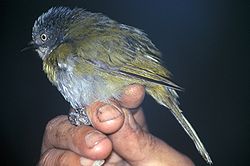| Chlorospingus | |
|---|---|
 | |
| Common chlorospingus (C. flavopectus) | |
| Scientific classification | |
| Kingdom: | Animalia |
| Phylum: | Chordata |
| Class: | Aves |
| Order: | Passeriformes |
| Family: | Passerellidae |
| Genus: | Chlorospingus Cabanis, 1851 |
| Type species | |
| Chlorospingus leucophrys [1] Cabanis, 1851 | |
| Species | |
Around 10, see text | |
Chlorospingus is a genus of perching birds, the bush tanagers, traditionally placed in the tanager family (Thraupidae). More recent studies which suggest they are closely related to the genus Arremonops in the Passerellidae (American sparrows). As of July, 2017, the American Ornithological Society assigns the genus to the new family Passerellidae, which contains the New World sparrows. [2]
It contains the following species:
| Image | Scientific name | Common name | Distribution |
|---|---|---|---|
| - | Yellow-throated chlorospingus | Chlorospingus flavigularis | northern Andes |
 | Yellow-whiskered chlorospingus | Chlorospingus parvirostris | northern Andes |
 | Ashy-throated chlorospingus | Chlorospingus canigularis | Talamancan montane forests and northern Andes |
 | Sooty-capped chlorospingus | Chlorospingus pileatus | Talamancan montane forests |
 | Common chlorospingus | Chlorospingus flavopectus | montane Neotropics |
| - | Tacarcuna chlorospingus | Chlorospingus tacarcunae | Panama, including Cerro Tacarcuna |
| - | Pirre chlorospingus | Chlorospingus inornatus | Cerro Pirre (eastern Panama) |
 | Dusky chlorospingus | Chlorospingus semifuscus | western slope of Colombian and Ecuadorian Andes |
The taxonomy and systematics of the common bush tanager are under review; it appears to be a superspecies or even a complex of superspecies. [3] [4] [5]